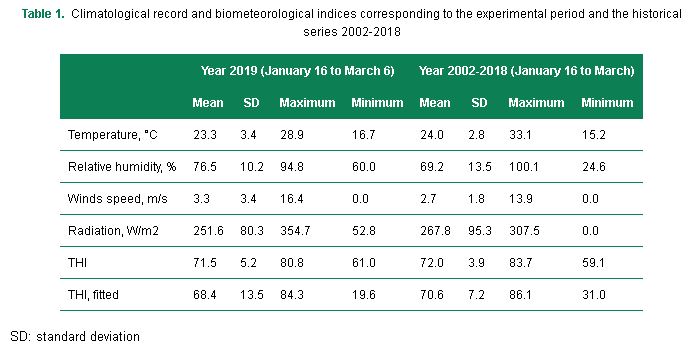Effect of supplementation with distillery grains and day confinement on the productive performance of Hereford steers, which graze forage sorghum (Sorghum, spp.) during the summer
Contenido principal del artículo
Resumen
In the West Coast of Uruguay, on six ha of forage sorghum, the effect of supplementation with more soluble dry distillery grains and day confinement with shade was evaluated on the productive performance of Hereford steers, which graze forage sorghum. A total of forty-eight steers (267 ± 29.5 kg) were randomly assigned to four treatments in a 2 x 2 factorial arrangement: free grazing without supplement, free grazing with supplement, day confinement without supplement, day confinement with supplement (n=2. 6 steers/repetition). It was grazed in weekly strips, with allocation of 8 kg of dry matter of grass/100 kg of live weight. Between 10:00 a.m. and 4:00 p.m., the animals with day confinement were moved from the grass to a near pen, provided with water and artificial shade. The supplementation with more soluble dry distillery grains improved productive performance, regardless of grazing management. Supplementation increased dry matter intake and increased live weight gain 2.9 times, with a weight gain response of 0.928 kg/d and supplement conversion efficiency of 3.1:1 (supplement intake, kg/response in LW gain, kg). The day confinement improved the thermal welfare of animals and did not affect the intake of dry matter or grazing activity. However, it was not enough to express improvements in mean daily gain.
Key words: steers, supplementation, more soluble dry distillery grains, day confinement.
Detalles del artículo
Aquellos autores/as que tengan publicaciones con esta revista, aceptan los términos siguientes:
- Los autores/as conservarán sus derechos de autor y garantizarán a la revista el derecho de primera publicación de su obra, el cuál estará simultáneamente sujeto a la Licencia Creative Commons Attribution-NonCommercial 4.0 International (CC BY-NC 4.0) que permite a terceros compartir la obra siempre que se indique su autor y su primera publicación esta revista. Bajo esta licencia el autor será libre de:
- Compartir — copiar y redistribuir el material en cualquier medio o formato
- Adaptar — remezclar, transformar y crear a partir del material
- El licenciador no puede revocar estas libertades mientras cumpla con los términos de la licencia
Bajo las siguientes condiciones:
- Reconocimiento — Debe reconocer adecuadamente la autoría, proporcionar un enlace a la licencia e indicar si se han realizado cambios. Puede hacerlo de cualquier manera razonable, pero no de una manera que sugiera que tiene el apoyo del licenciador o lo recibe por el uso que hace.
- NoComercial — No puede utilizar el material para una finalidad comercial.
- No hay restricciones adicionales — No puede aplicar términos legales o medidas tecnológicas que legalmente restrinjan realizar aquello que la licencia permite.
- Los autores/as podrán adoptar otros acuerdos de licencia no exclusiva de distribución de la versión de la obra publicada (p. ej.: depositarla en un archivo telemático institucional o publicarla en un volumen monográfico) siempre que se indique la publicación inicial en esta revista.
- Se permite y recomienda a los autores/as difundir su obra a través de Internet (p. ej.: en archivos telemáticos institucionales o en su página web) antes y durante el proceso de envío, lo cual puede producir intercambios interesantes y aumentar las citas de la obra publicada. (Véase El efecto del acceso abierto).
